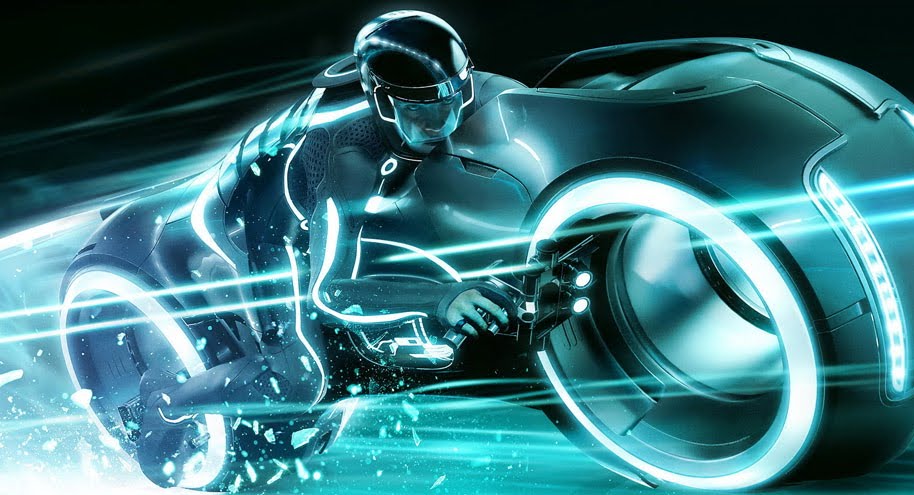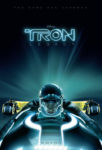The year was 1982. The Decade was well underway, and thanks to Rocky II , Survivor’s “Eye of the Tiger” was roaring up the charts, and Men At Work’s “Down Under” wasn’t too far behind. A young Kirsten Dunst and Seth Rogen were born. E.T.: The Extra-Terrestrial was one of the highest-grossing box-office successes, and Chariots of Fire would go on to win Best Picture at the Academy Awards.
Then there was TRON, Disney’s science-fiction action film that has been ridiculed and praised in equal measure over the three decades since its original release. Although the official story is that director Steven Lisberger was inspired by the 1976 video game Pong, Disney – like many other studios at the time – were madly scrambling to find a way into the sci-fi dollar, following the massive success of Star Wars and its 1980 sequel, The Empire Strikes Back. Their minor hit with Black Hole in 1979 had been one of the most expensive films the studio had produced, and resulted in some of the more innovative special effects of the time.
TRON, of course, would wow audiences with its own impressive use of special effects. Combining some of the earliest computer generated animation with live action for the first time ever, coupled with production design by French comic book artist Moebius (Alien, The Abyss) and Syd Mead (Blade Runner, released the same year), TRON had a look that was instantly iconic. Despite this, TRON wasn’t even nominated for an Academy Award for special effects. Director Lisberger maintains that “The Academy thought we cheated by using computers”, an attitude that clearly didn’t last long with the now commonplace use of computer generated imagery in movies. Despite these setbacks, and some major critical reactions against the film, TRON has gathered a large fan-base over the last thirty years. Comic books, novels, theme park rides, and of course, video games have peppered the landscape, and the possibilities of computer generated imagery reportedly inspired Pixar to embark on the journey that would begin with Toy Story. So it seems it was inevitable that there would be a sequel, but nobody working on the original film could have imagined it would take almost 30 years to reach the screen.
TRON: Legacy begins in 1989, seven years after the events of the first film. Kevin Flynn (Jeff Bridges, The Men Who Stare at Goats) recounts to his young son the story of how he liberated the world inside the computer mainframe from the hands of the Master Control Program, leaving behind a digital version of himself (CLU) to help shepherd in a new digital frontier in the virtual environment. Shortly after imparting this tale, Flynn goes missing, leaving his son orphaned but with a controlling interest in his company ENCOM, a software company with a philosophy of open access. Over twenty years later, the adult Sam (Garrett Hedlund, Friday Night Lights) is a rebel without a cause, except for the annual sabotage against the now highly corporate ENCOM. When company executive and old friend Alan Bradley (Bruce Boxleitner, Babylon 5) tells Sam of what could be a message from his father, it sparks a journey that will lead Sam into the mainframe world his father created, where he becomes a player in the world now controlled by the corrupt CLU. Sam must reunite with his father and help battle Flynn’s doppelgänger and once again liberate the digital frontier.
From the TRON-ified Walt Disney Pictures logo that opens TRON: Legacy, it is clear that it is going to be a deliberately targeted visual feast. Set almost entirely in the digital world, with the exception of two bookend sequences, the film is filled with a variety of futuristic and crisp blues, whites, yellows, reds and dark-as-the-night blacks. Indeed, it is tough to recall a single other colour used throughout the film, given the dominance of this strong scheme. The process is an effective one, completely updating the electronic future as seen from 1982 to the rather minimalist future that we now live in thanks to the sleek tablets and smartphones of Apple and its copycats. In this sense, director Joseph Kosinski’s commercial background is used to full effect in his big-screen directorial debut. As contradictory as it may sound, this has all the sheen of an art piece in a commercial blockbuster setting. The carefully placed white ornaments of the Zen hideaway of Flynn, the deliberately lingering shots of Quorra (Olivia Wilde, House) lounging on a crisp white couch in her tight black outfit and even the appearance of iconic electronic artists Daft Punk (who also provide the excellent soundtrack) all serve the same purpose: to spark an instant association with cool that comes with the festishisation of all things future and minimal. Boy, does it work.
The real visual treat is that we get not one but two Jeff Bridges, thanks to some neat digital trickery allowing a young version of Bridges to walk and talk in 2010. Although there is some minor glossiness to his look, the technology that enabled this is both amazing and potentially frightening. Bridges’ aged Flynn draws on his own cinematic history, seemingly aping some of the laconic wisdom of his character The Dude in The Big Lebowski, especially when dropping pitch-perfect lines like “It was bio-digital jazz, man!”. The Dude abides. Garrett Hedlund fares capably against this seasoned actor, but they really all just have their parts to play in this monumental effects undertaking. Effects aside, the writing team of Edward Kitsis and Adam Horowitz (both of TV’s Lost) provide a relatively minimalist plot to match the background, paying only the merest of lip-service to the philosophical debate between commercialisation and free access to digital creations. It rips along at a pace, and only really falters once with the introduction of Michael Sheen’s (The Special Relationship) Ziggy Stardust-inspired club owner, who threatens to topple the whole thing over into farce (but only a little bit). It is a fairly standard ‘good versus evil’ plot, complete with a handy colour scheme for ease of team identification, but any more complexity would be missing the point.
TRON is back for a new generation, and the transformation is a complete one. It may have taken thirty years to make it back to the big screen, but with any luck Disney may have another bona fide hit on their hands and the start of a new franchise to rival The Pirates of the Caribbean. It could be the start of a new digital frontier, as Flynn might say. Yet if we do have to wait another 30 years for another TRON, who knows what the future will look like then.
Tron: Legacy is now playing nationally at cinemas around Australia and in IMAX 3D.






No Responses